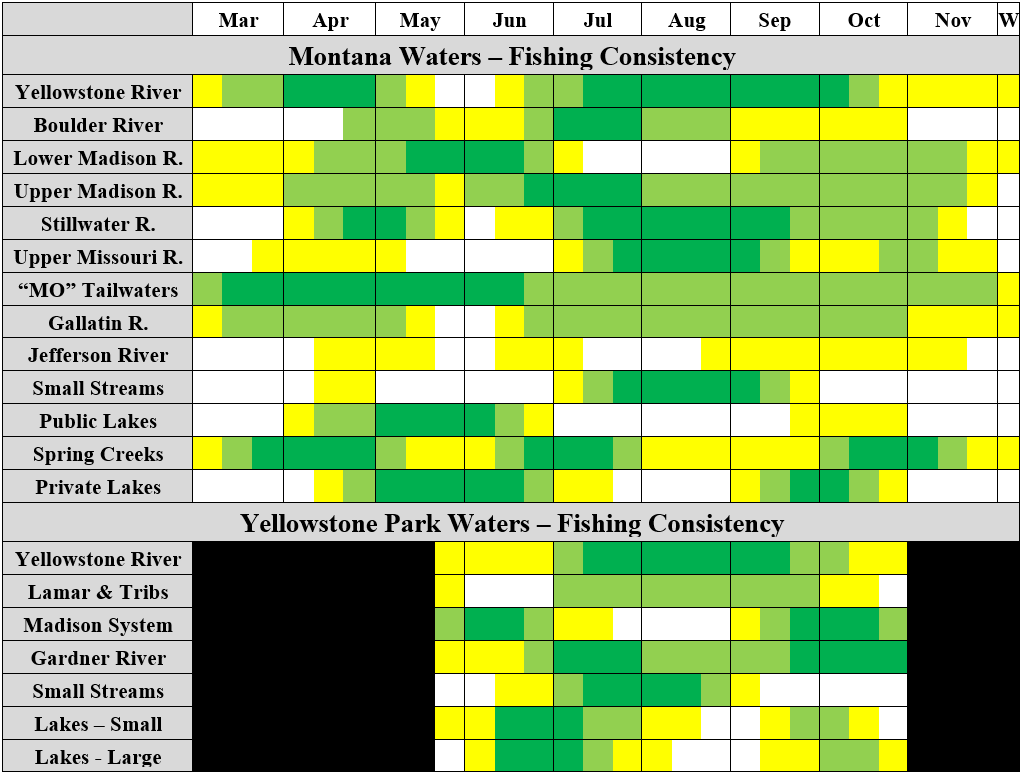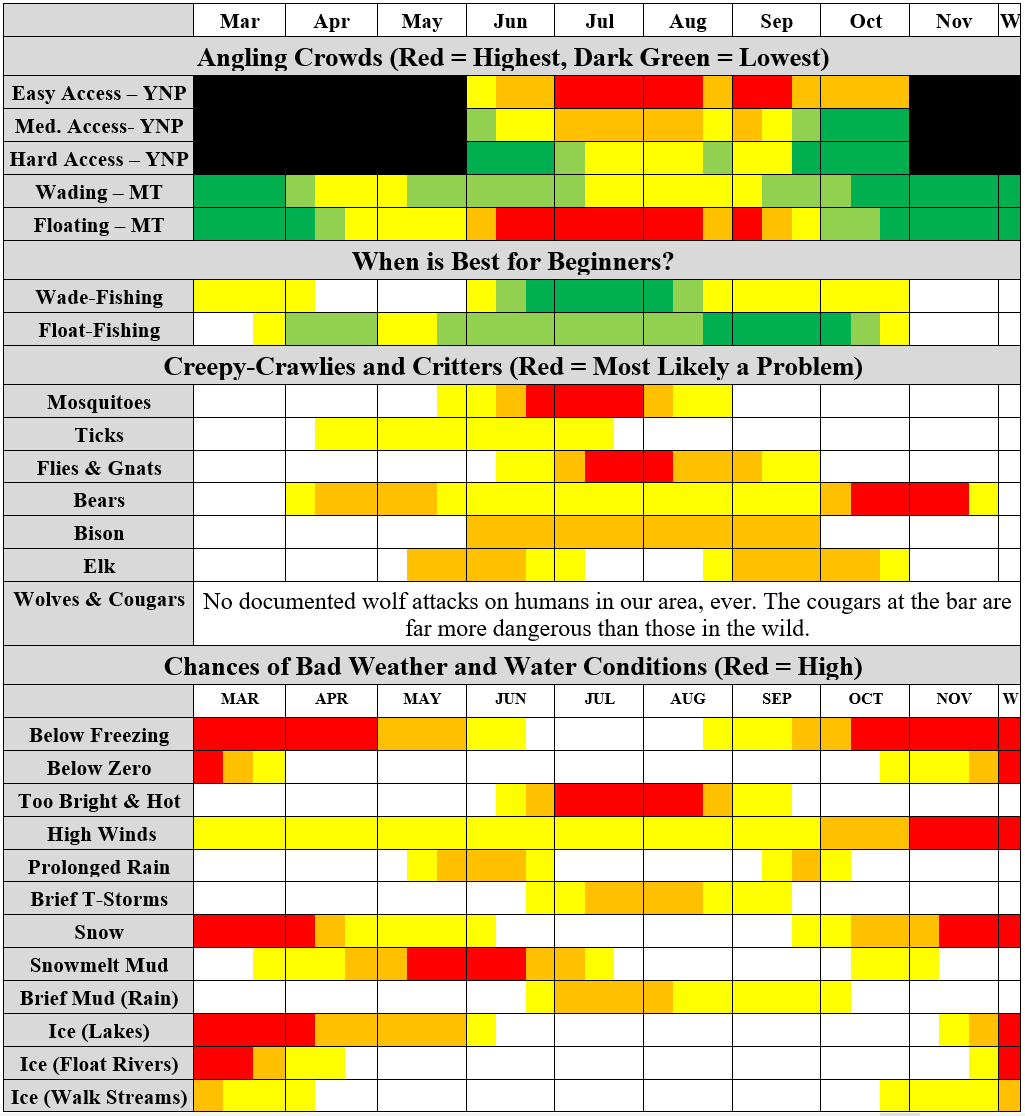What to Expect Whenever You Fish the Livingston Area: Crowds, Fishing Quality, Bugs, Bear, Bison, Etc.
Fishing near Livingston, Montana is highly seasonal. Fishing on some streams and lakes is good at certain times of year but awful or closed at other times. By the same token, certain periods are productive for some fish species but not for others.
Use the charts and info on this page to decide when and where to fish, and what species to target. Note that these charts and descriptions assume near-normal weather and water conditions. Abnormally high or low water or hot or cold temperatures can shift things. Drought years in particular may have very difficult conditions from roughly July 20 until roughly August 20, whereas in normal and especially high water years this is actually the very best period. By the same token, many waters see unfishable runoff until early July in wet years, but may see the year’s best fishing in late June and early July during dry years.
For the most up-to-date info, keep an eye on our blog. We post snowpack updates and season fishing forecasts there starting irregularly in January and regularly in February.
For information on legal seasons, which have little to do with when the fishing is actually good (the Yellowstone is open but terrible in late May, whereas the Gardner is closed but would be great in February, for two examples), please visit the regulations page.
When are the Best Times to Fish Near Livingston? How About the Worst Times?
This is the short version of the rest of this page. The following table takes into account everything: how many quality places to fish near Livingston are available, the consistency of the fishing, the weather, the crowds, everything. Green periods are top-shelf. Red periods are bad.

Here’s the skinny in writing:
- The best time to fish near Livingston is from late June through early October. The fishing remains good but gradually declines through the fall.
- The worst time to fish near Livingston is in December and early January. No surprise there. The real surprise is that the fishing actually improves steadily through January and February, and March can be quite good even if there’s still ice and snow around. Why? More sunlight. Even if the air is still bitter, more sun getting into the water stimulates insect activity. Late February and March can be awesome in the right places. There just aren’t many right places in late winter.
- The April high point is much better for flexible, experienced anglers looking for larger fish than it is for beginners and casual anglers, though there are good options for beginners in April, too. Just cross your fingers it is neither unseasonably cold (it can snow a lot in late April) or unseasonably warm (that snow can start melting early and turn the best rivers muddy).
When Does Fishery X Produce?
Plenty of anglers want to fish a specific body of water or type of water and want to come when these areas are at their best. Others already have their travel plans set and need to know where to fish when they’re coming.
Whichever category you fall into, the following chart will help. It tells when most major waters within reasonable range of Livingston (3hr) are likely to produce, including a couple that aren’t discussed in detail elsewhere on this site. Green is best for a given water (or type of water). Yellow means inconsistent—sometimes it’s good, sometimes it stinks. White means a spot is technically open but probably not a good bet unless conditions are very unusual. Sometimes these “unusual” weather conditions might lead to the best fishing of the season. This is common for example on the Yellowstone River in Montana, which is usually too muddy to fish in late May and early June. When it isn’t too muddy, it’s awesome. It’s just impossible to plan for such conditions more than a few days ahead of time. Black means the season is closed.

I Want to Catch Species X. When Should I Come?
Got a specific target quarry in mind? Hoping for a big one? The following chart tells you what you need to know. Note that this chart covers the region in general. Specific waters may fish differently. Chances of a big brown trout are much higher on the Gardner River in October than they are in July, for example, while the Yellowstone River in Montana actually turns out a lot of big browns in the middle of summer.
If you’re looking for a variety of places to fish, the bottom section of the chart will help. Green means there are lots of good places. Yellow or especially white means good areas are limited and you might have to fish the same place all or most of your trip. Black means the season is closed.

Other Concerns
The following is a bit of a grab bag covering concerns that might govern when you want to fish here.
Regarding Crowds, the number of available fisheries plays a role. Early June and late October wade-fishing is somewhat crowded only because there aren’t many good places. Same with May and June floating.
By the way, those orange “holes” in the red high crowds are supposed to be there. Despite what many visitors think, the last ten days of August are consistently less crowded than much of September. If you’re surprised, that’s one reason why. Everybody who thinks the crowds decline in September plans to come then, thereby creating a crowd of people all trying to beat the crowds. Lamar System crowds are particularly bad in September. Late August is the real sleeper bet if you’re trying to shed crowds without much chance of seeing snow.
Regarding Animals and Bad Weather, the darker the color, the more the animal or weather condition could be a factor in where/when it’s possible to fish and how concerned you should be about potential dangers. The weather is a far bigger factor than animals.
Regarding the animals, there are a few good rules of thumb:
- Carry bear spray and know how to use it.
- Practice other “bear-aware” safety measures. Most of these pertain to proper food storage and making noise when traveling through areas with short sight lines to avoid surprising bears or other animals.
- Give animals space, especially cow elk in calving season (May and June), bull elk during the rut (September and October), and for $#!+ sake don’t try to pet the bison. I’ve seen it done. The vast majority of injuries from animals come from “tourons” of all ages being extraordinarily stupid.
